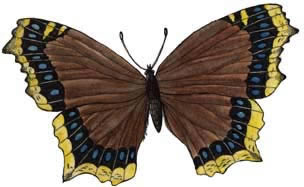

They are found all over North America south of the Canadian tundra, south into central Mexico. They are also found in Asia and Europe.
They live along forest borders, roads, rivers and fields.
They have slightly shiny, brown, wings with a row of blue spots and yellow edges. They are plain colored underneath so they can hide against tree bark. Their wingspan is up to 4" wide.
They are often seen fluttering along the ground in early summer. The adult butterflies can live for almost a year which is a very long time for a butterfly.
Their caterpillars eat willow and poplar leaves. Adult butterflies eat tree sap.
Females lay eggs around the twigs of willows and poplar trees. The caterpillars live together in a web and feed together on young leaves. They come out of their chrysalis as adults in June.
Kingdom: Animalia
Phylum: Arthropoda
Class: Insecta
Order: Lepidoptera
Suborder: Macrolepidoptera
Family: Nymphalidae
Genus: Nymphalis
Species: N. antiopa
When you research information you must cite the reference. Citing for websites is different from citing from books, magazines and periodicals. The style of citing shown here is from the MLA Style Citations (Modern Language Association).
When citing a WEBSITE the general format is as follows.
Author Last Name, First Name(s). "Title: Subtitle of Part of Web Page, if appropriate." Title: Subtitle: Section of Page if appropriate. Sponsoring/Publishing Agency, If Given. Additional significant descriptive information. Date of Electronic Publication or other Date, such as Last Updated. Day Month Year of access < URL >.
Amsel, Sheri. "Butterfly (Mourning Cloak)" Exploring Nature Educational Resource ©2005-2024. March 27, 2024
< http://www.exploringnature.org/db/view/285 >

